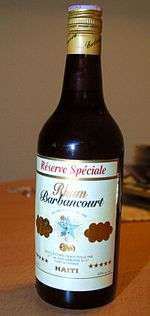Rhum Barbancourt
 | |
 | |
| Private | |
| Founded | 18 March 1862 |
| Founder | Dupré Barbancourt |
| Headquarters |
16, rue Bonne Foi BP 33, 2497 Port-au-Prince Haiti |
Area served | Worldwide |
Key people | Thierry Gardère, CEO |
| Products | Rum |
| Revenue | US$12 million (est. 2009) |
| Website |
barbancourt |
Barbancourt is a rum produced and bottled in Haiti by Société du Rhum Barbancourt, T. Gardère & Cie.. The company is one of Haiti's oldest, and its rum is one of the country's most famous exports, widely regarded as among the finest rums in the world.[1]
Company history
The family business began on March 18, 1862, producing rum directly from sugar cane juice. Dupré Barbancourt, a Frenchman from the cognac-producing region of Charente emigrated to Haiti, and founded his company at the end of 1862. After learning how to make rum in December of that year, he soon began selling it for HTG 1.50 (USD $0.30) per gallon.[2]
Dupré Barbancourt left no heir and when he died the company passed to his wife Nathalie Gardère, who managed it with the help of her nephew, Paul Gardère. When she died, Paul then directed the company’s destiny until his death in 1946, when his son Jean Gardère took up the baton, furthering the family tradition until 1990. When Jean passed, Thierry Gardère took over, becoming the fourth generation of the Gardère family to lead the company.
During the 2010 Haitian earthquake, two workers died, about 86 lost their houses, many aging barrels were destroyed, halting the rum production,[3] and rum supply and prices were affected. By May 2010 however, production had already resumed.[4]
Expansion and operations
In 1949, the company relocated to the heart of the sugar cane fields of the Domaine Barbancourt in the plaine du Cul-de-Sac region. By 1952, the successful company ramped up production, transforming itself from what once was a cottage industry into a major producer of quality rum. The rum is double distilled, using a process similar to that used to produce cognac.
Barbancourt is made directly from sugar cane juice rather than the sugar cane by-product molasses. This is similar to the rhum agricole of Martinique, which is strictly controlled by law. Fermenting fresh sugar cane juice provides a more flavorful product.[5] Cachaça, from Brazil, is another alcoholic beverage made from fresh sugar cane juice.
Barbancourt's products are highly regarded and have won many tastings and competitions, and have won excellent reviews from rum connoisseurs. Available in the United States, its Estate Réserve is aged for 15 years. Within the Caribbean region, the original Réserve du Domaine is also aged 15 years, and each bottle previously had a unique serial number—however the labels have changed recently and this is no longer the case. Other popular products include the 5 Star Réserve Spéciale aged for eight years, the 3 Star rhum aged four years and a clear, white rhum, all made from fresh sugar cane juice.
Barbancourt's rums are marketed in 20 countries, namely the Caribbean, the United States, France, and Italy. Barbancourt is among Haiti's best known companies internationally.
Products
- Rhum Barbancourt White Rhum
- Rhum Barbancourt 3-Star (aged 4 years)
- Rhum Barbancourt 5-Star (aged 8 years)
- Rhum Barbancourt Estate Reserve (aged 15 years)
- Pango Rhum (aged and macerated with pineapple, mango and spice)
See also
References
- ↑ Women and Children's Tribulation In Haiti. Retrieved 6 March 2014.
- ↑ Schutt-Ainé, Patricia (1994). Haiti: A Basic Reference Book. Miami, Florida: Librairie Au Service de la Culture. p. 41. ISBN 0-9638599-0-0.
- ↑ http://www.tradenewsonline.com/content/show/id/7187
- ↑ http://blog.gfbcproductions.biz/2010/05/14/classic-haitian-rum-barbancourt-back-in-production/
- ↑ Women and Children's Tribulation In Haiti. Retrieved 6 March 2014.